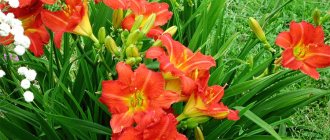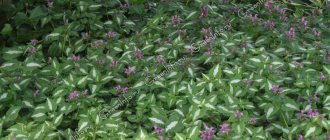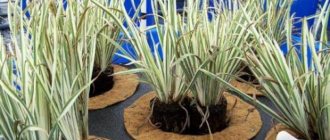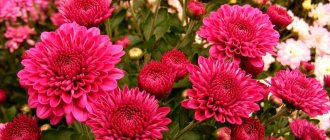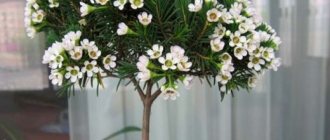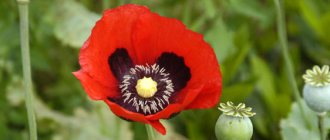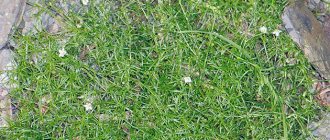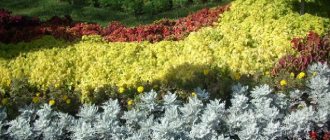What is a plant?
The fern's unique ability to adapt to its environment has allowed it to survive all disasters and climate changes.
A fern has no roots in the usual sense. Their role is played by a horizontal stem, from the axils of which adventitious feeding roots emerge.
From the buds on ground stems grow scaly, feathery leaves - fronds. They form a complex system of shoots - flat branches. The fronds participate in photosynthesis, and spores ripen on their underside. The length and number of processes varies for each species, some are twisted in the shape of a snail or spiral.
Is the structure shrub or grass?
In nature, there are many varieties of ferns, divided into ancient and modern. Main classes:
- Psilotoides - consist of erect stems where photosynthesis occurs. On the shoots, instead of a leaf plate, there are only rudiments.
- Uzhovnikovye - branches with one leaf, divided into an upper and spore part. It has the rudiments of a conducting system and educational tissue.
- Horsetail - the name was given because of its external resemblance to a horse's tail. The shoots alternate nodes and internodes evenly. The nutrition and exchange system is located in the stems. Horsetail was the first to develop true roots with developed appendages.
- Marratiaceae are one of the largest modern representatives. They live in tropical forests, fronds grow up to 6 m long.
- True ferns are the most multifamily class and are widespread on land and in water.
Ferns are herbaceous plants, but some species are classified as shrubs. It depends on the type of structure and development of the shoots.
Conclusion
Now that we have found out everything about planting and caring for ferns in the garden, let’s summarize.
- Choose a location that is fully shaded or partly shaded. In the summer sun, the plates will burn and look unattractive.
- Prepare loose, light soil. To replant a forest plant, take some soil from where it grew.
- Dig a hole slightly larger than the root system.
- Add compost or a pinch of nitrogen fertilizer to the bottom.
- Place the seedling in the hole, straighten the roots and cover them with soil. A flower from the forest must be planted in a permanent flowerbed before it begins to fade.
Don’t forget to regularly water and loosen the soil and the delicate, emerald greenery will delight you for many years. Do not leave the bush in flowerpots on the site for the winter - replant it in open ground in September or bring it indoors. Now you know how to plant a fern correctly, all you have to do is choose a variety and wait for the right time for gardening work.
Reproduction methods
In an adult fern, on the lower half of the leaf there is a capsule - sporangium , in which spores mature.
When it bursts, the cells fall off and are carried away by the wind. When they land on the ground, they develop gametophytes - bisexual growths, where fertilization occurs and a zygote is formed. The embryo attaches to the soil or plant and a new fern grows. Ornamental species are propagated by dividing the bush in the spring and rooting shoots.
The life cycle is divided into two stages: sexual gametophytic and sporophytic, when asexual cells appear to seed a new generation.
Video about methods of fern propagation:
How to prepare and store fern
Calendula flower-marigold - what it looks like and where it grows
Bracken is an edible fern. It is rarely consumed in Russia; dishes made from this plant are considered exotic. In the world, especially in Japan, such a cuisine, unusual for Europeans, is very developed; the Orlyak pagon appetizer is a fairly popular and familiar dish.
The shoots of young ferns, called rachis, are used as food. They appear in early May and resemble a snail in appearance - the top of the petioles is wrapped in a spiral. The shoots are collected before the first leaves appear - the mature plant becomes poisonous.
Collection
For cooking, rachis no larger than 30 cm are used; they are cut at a height of 5 cm from the ground. The sprouts are sorted by color and size, aligned along the top edge, tied, and the bottom is cut off straight. You can store fresh stems for no more than 10 hours after collecting them; you need to start preparing rachis for the winter after 2-3 hours - this way the maximum amount of useful things is preserved.
Attention! Under no circumstances should the shoots be consumed raw – this can cause serious harm to the body.
For industrial production, the pagons are salted. At home, fern is prepared by drying, freezing or pickling.
Drying fern
Drying sprouts allows you to preserve the original taste of the plant. Dense and large shoots up to 20 cm long are selected, pre-blanched in salted water for several minutes, then they are transferred to a colander and washed with cold water - this helps to preserve the elasticity and juiciness of the fern.
Blank
It is very important not to overcook the rachis, otherwise they will become tasteless and flaky. When the shoots have cooled and the remaining moisture has drained off, you can begin drying.
You can dry the resulting workpiece in two ways:
- On open air. The process is long and quite painstaking. It is necessary to prepare a well-ventilated, dry room, place the fern on paper or in a special net for drying vegetables. Over the course of 5-7 days, the sprouts are periodically turned over and slightly kneaded.
- In an electric dryer. Express harvesting method. The prepared shoots are placed in an electric dryer in a thin layer and dried at a temperature of 50 degrees for approximately 6 hours. You should be careful - the drying time largely depends on the size of the pagons. It’s better not to dry them a little, than to overdry them and lose the results of your labor.
Drying
Dried pagons are placed in fabric bags, which are hung and left in the fresh air for another couple of days to dry at natural temperature and humidity.
Advice. The quality of the product can be determined by the appearance of the rachis - properly dried pagons retain their characteristic aroma, plasticity, and acquire a rich green or brown-green color. If the sprouts break, they may be overdried.
A very important nuance in the preparation is how to store dried fern. The shoots are placed in paper or fabric bags and left in a dark, dry room. In case of high humidity, it is better to transfer the pagons into a glass container that closes tightly. In this state, the product retains its quality for two years.
Freezing fern
A simple and effective method for preparing shoots that are virtually indistinguishable in appearance and taste from the fresh product is freezing ferns:
- The sprouts are selected, washed, and cut into convenient pieces.
- Blanch in salted water, drain in a colander, and rinse with ice water.
- After the liquid has drained from the shoots, they are dried on a towel or paper and cooled.
- The finished rakhis are transferred to food zip bags or plastic containers and placed in the freezer.
Freezing
Another interesting way to prepare Orlyak is to marinate it. To do this, boiled salted sprouts are placed in jars and filled with marinade with soy sauce, apple cider vinegar, garlic, sugar and salt.
Pickling
The result is a delicious snack reminiscent of pickled mushrooms.
Where is it used?
Over hundreds of years, layers of fern remains rotted into a peat-like substance, the deposits of which hardened and gradually turned into coal.
Today's species serve as habitats for many animals and interact in symbiosis with other plants. Fern is used in many areas of human activity:
- consume edible varieties, especially popular in East Asian countries;
- in medicine, ferns with antispasmodic, antibacterial and antiviral properties are used;
- in agriculture for peat formation and fertilizer production;
- in landscape design and as indoor plants.
The ability of fern to adapt to new living conditions on land and in water distinguishes it favorably from other representatives of the flora. It is valued for its healing qualities and nutritional value. Decorative species are used in landscaping, room decoration, and arrangement of ponds and aquariums.
What ferns are found in our area. Main menu
What ferns are found in our area?
Some of the oldest inhabitants of our planet, dating back to the Paleozoic era.
This plant has many species with their own subspecies, which have unique, dissimilar characteristics when compared one to another. Accordingly, different areas mean different types of ferns. They are widespread, so they can be found in different zones - from subtropics and tropics to ordinary broad-leaved forests, where this type of tree fern is found with some differences from its counterparts. The climate of the territory of Ukraine has always been characterized by an average climate, so we can find ferns in special places, such as swamps, forests, shady areas, which is why many legends and beliefs have arisen associated with the fern plant and which helped to carve in the national memory its image as a mystical plant.
What will take root on it largely depends on the properties of the soil, so the ferns that are found on our territory are also ranked according to the type of soil mixture. One of the most common types of fern that you can come across is the bracken fern, which grows mainly on dry soils, that is, loamy or sandy loam, and therefore closer to forests and wooded areas.
However, one of the most beautiful representatives of the class of fern plants, the Ostrich fern, has a very interesting name. It is this fern that can often be seen in thematic images, because its leaves float like the feathers of an ostrich, also gracefully, lightly and softly.
Brown osmunda is one of the representatives of fern plants in our area. This plant is somewhat similar to the previous fern representative, however, there are still some differences in appearance, but this in no way takes away from the amazing appearance of this plant. It usually grows as a very tall plant and sometimes even reaches two meters in height!
Stop-shaped Adiantum, a fern with a very unusual name, is also located on our territory. It is interesting because it grows on any soil, especially well on flooded soils or with a high content of groundwater. In such moisture, as you yourself understand, not all plants survive, so it is worth paying tribute to this fern, which decorates our swamps, giving them a mystical touch.
The most interesting and widespread, perhaps, will be a fern called Deer Horn. This plant is considered an ornamental plant, so you can spot it in gardeners’ gardens and also see it in the forest. This plant can only be competed by a type of fern called alzophila, which is very unusual in appearance, however, not so common. The similarity between these two species is that both of them are used for decorative purposes mainly, but the latter is rather grown almost to order, as if you won’t find it in the forest, because it needs conditions appropriate for life, which are created by man-made plants. way.
Please rate the material you read :)
(1 rated, rating: 4.00 out of 10)
The entry was published by the author of toNature.info in the category Catalog, Decorative foliage. Bookmark the permalink.
